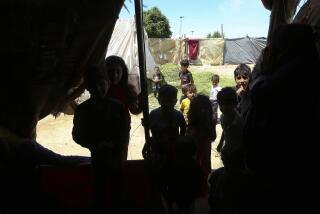Jordan Valley Offers Clues on Human History
- Share via
PELLA, Jordan — The fertile hills around the ancient settlement of Pella are yielding traces of a million years of human activity in the Jordan Valley.
Archeologists digging here for 12 years under the direction of Prof. Basil Hennessy of Sydney University in Australia have uncovered a record of human existence reaching back to Stone Age hunters and forward to Ottoman times, and most of the years in between.
“With this single site, we will eventually be able to rewrite the entire archeological history of northern Jordan,” said dig coordinator Alan Walmsley, also of Sydney University.
Pella, watered by a perennial stream, lies at about sea level in the once-forested foothills of the northern Jordan Valley, 55 miles northwest of Amman.
A popular picnic spot, especially when spring flowers carpet the hillsides, it once straddled ancient trade routes linking Arabia, India and China with Syria, Anatolia, Greece and Rome.
Villagers now graze flocks of sheep and goats among the remains of Roman, Byzantine and Islamic buildings that dot the slopes overlooking the Jordan river.
But the visible ruins, less spectacular than the ancient rock city of Petra in the south or the Greco-Roman town of Jerash to the east, tell only a fraction of Pella’s story.
“The importance of Pella is that we are establishing a historical and occupational sequence of the site from the very earliest periods down to the Ottoman era,” said Ghazi Bisheh, director of Jordan’s antiquities department.
He said the discovery of an Abbasid settlement at Pella could help to change a widely held view that Jordan declined in population and importance after the Abbasids defeated the Omayyad dynasty and transferred the capital of the Muslim empire from Damascus to Baghdad in the mid-8th Century.
“There’s now strong archeological evidence that the decline was not as drastic or comprehensive as thought,” he said.
Occupation at Pella moved slightly north of earlier sites after an earthquake in AD 747.
“It has given us the best collection of Abbasid pottery and glass in Jordan,” said Australian archeologist Margaret O’Hea. “We have complete vessels dating from the 8th to the 10th Centuries, as well as a city street and a courtyard.”
The absence of earlier or later remains at the site, just three feet below the surface, allows precise dating.
“Several seasons of meticulous work at Pella have allowed notable advances in our knowledge of the ceramic typology of the Byzantine, Omayyad and Abbasid periods,” Bisheh said.
Until geological changes culminating about 11,000 years ago, Pella lay by a giant lake known as Lissan of which the present-day Dead Sea and Sea of Galilee were part, Walmsley said.
Stone tools to butcher animals were discovered at a camp used by hunter-gatherers near Pella around 17,500 BC.
Basalt handmills, mortars and pestles found near Pella point to agriculture emerging after the end of an ice age brought warmer temperatures. The 650-feet-deep lake slowly receded because of evaporation and movements in the Earth’s crust.
Excavation of a settlement at Wadi Hammeh, one mile from Pella, has shown that people of the Natufian period around 10,000 BC gathered wild barley and other plants, hunted gazelle, sheep and goats, and practiced arts and crafts.
Their mudstone slabs engraved with concentric square motifs--prized finds for the Pella archeologists--are among the earliest surviving “rock-art” from the prehistoric Near East.
By the 16th or 15th Centuries BC, Pella appeared to have been a prosperous city, trading with Cyprus, Egypt and Syria.
A beautifully carved ivory inlaid box from this period is among a range of cultural artifacts that include silver and jewelry, cosmetics in alabaster vessels, conch shells, steatite scarab signets, gold thread and bronze pins.
The city’s fortunes ebbed and flowed until it was abandoned for more than two centuries of Persian rule from 539 BC to 332 BC.
Contemporary historians began referring to Pella again after Alexander the Great conquered the Middle East in 333 BC and it enjoyed fresh prosperity in the 2nd and 1st Centuries BC, trading widely and minting its own currency.
It continued to expand under Roman rule in the first 300 years after Christ and had a population of up to 25,000 in the Byzantine era in the 5th and 6th Centuries.
Decline linked with earthquakes, invasions and plague affected Pella before the Muslim army defeated the Byzantines at nearby Fihil in AD 635 and subdued the city peacefully.
Archeological evidence indicates that a Christian minority coexisted with the Muslims for centuries after the Islamic conquest, but Pella gradually lost its importance as a trading center and was abandoned sometime during the 16th Century.
More to Read
Sign up for Essential California
The most important California stories and recommendations in your inbox every morning.
You may occasionally receive promotional content from the Los Angeles Times.













